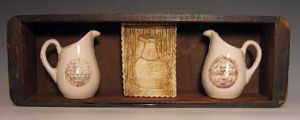In today’s feature, Philadelphia ceramic artist Paul Andrew Wandless gives a primer on using decals on ceramic work. Paul discusses the various options of decal papers that can be used on ceramics and pottery. We’ll follow up on Friday with a video from Pittsburgh artist Justin Rothshank, who will demonstrate how to apply decals. - Jennifer Harnetty, editor.
There are three kinds of decal paper that can be used for just about any image: traditional, laser and Lazertran. All three types are applied using the water slide process, which consists of soaking the decal in water until it separates from the paper backing then sliding the image onto the surface (this will be demonstrated in Justin Rothshank's video on Friday). The process varies with each type of decal paper.
Use the water-slide process to apply decals on already-fired glazed surfaces. Refire using the suggested temperature and firing schedule of the overglaze or china paint being used, usually Cone 023 - 018 depending on the color. Leave about 2 inches of space around and above the piece in the kiln to allow for fuming during firing. If you bisque and glaze fire in the same kiln, you should fire it empty to Cone 01 to burn out any sulfur build up in the softbrick of the kiln. Sulfur fumes not only effect decal adhesion, but can also effect how your colors turn out.
| Safety Precautions Some kilns have venting systems capable of handling the fumes, but check the manufacturer’s instruction book for your kiln to determine its ventilation capabilities. Unventilated kilns can be fired with the lid propped slightly and the spy holes open so fumes can escape. Close the slightly propped lid and plug the spy when the kiln reaches red heat inside. |
Traditional Decal Paper
Traditional decal paper comes with a thin, gelatinous layer already on the paper, which appears as a shiny surface. An image or design is created on this gummed surface, then a lacquer cover coat is applied sealing the image to the backing paper. The image needs to be sandwiched between these two layers so it holds together during the water-slide process. Oil-based overglaze or china paints are typically used creating rich and vibrant colors when fired. Single or multicolored overglaze images can be screened, handpainted or both onto the decal paper.
Laser Toner Decals
Laser decal paper is used only in laser toner printers and copiers to create black- to sepia-toned images (the pitchers in the photo below have laser toner decals on them). The color results from the iron content in the toner and can be fired at a variety of temperatures in the kiln. Bel, Inc.. makes a laser/copier decal paper in 8 ½ by11-inch sheets. The image
 becomes fused to a very thin plastic layer over the gelatinous layer already on the backing paper so a cover coat is not needed.
becomes fused to a very thin plastic layer over the gelatinous layer already on the backing paper so a cover coat is not needed.Different brands of laser printers and laser copiers have different percentages of iron, which affects the lightness or darkness of the image. Some may not even have enough iron oxide to produce any image. Bubble jet and inkjet printers won’t work since they use little or no iron oxides in the inks. You can use traditional decal paper to make laser toner decals, but you’ll need to spray them with a coat of lacquer before transferring them to a clay surface. Laser decal paper, however, cannot be used for anything but this process.
Lazertran Decal Paper
Lazertran makes two specialty decal papers for ceramic surfaces that don’t require firing or cover coating. One is used in a color printer to make a full-color reproduction of an image and the other is used in inkjet printers. You can print any kind of image onto these decals making this process an appealing option for nonfunctional work.
These nonfiring, full-color decals are fairly durable with good image clarity. They don’t permanently fuse with the glazed surface like a kiln-fired decal does, which makes them vulnerable to scratches, but the image can be coated with an acrylic sealer for added protection. Note: This type of decal is for aesthetic or decorative purposes only and is not food safe or to be used on functional work.
Use the water-slide process to apply the decal to a fired glazed surface then use a solvent, such as odorless turpentine, to adhere the image. Brushing on a very light coat of turpentine softens the gum substrate and the decal image essentially melts onto the glazed surface. The image bites into the surface for a secure adhesion, but isn’t physically part of the glaze itself. After a few hours of drying, it’s done. The unprinted areas of the Lazertran decal used in color copiers will be transparent after they are adhered with turpentine. Unprinted areas will stay white on the inkjet decals, but a coat of polyurethane can be applied after it’s adhered to make it transparent.
Paul Andrew Wandless is a studio artist, workshop presenter, educator and author. To see more of his work, visit www.studio3artcompany.com.
